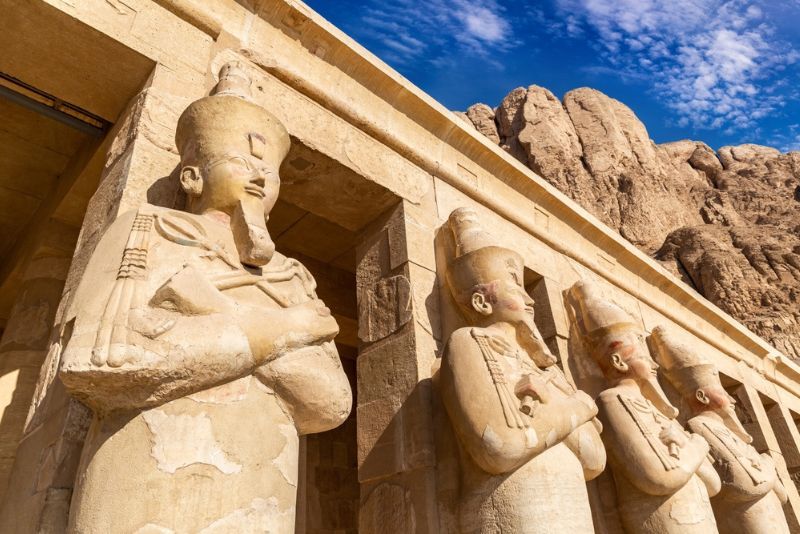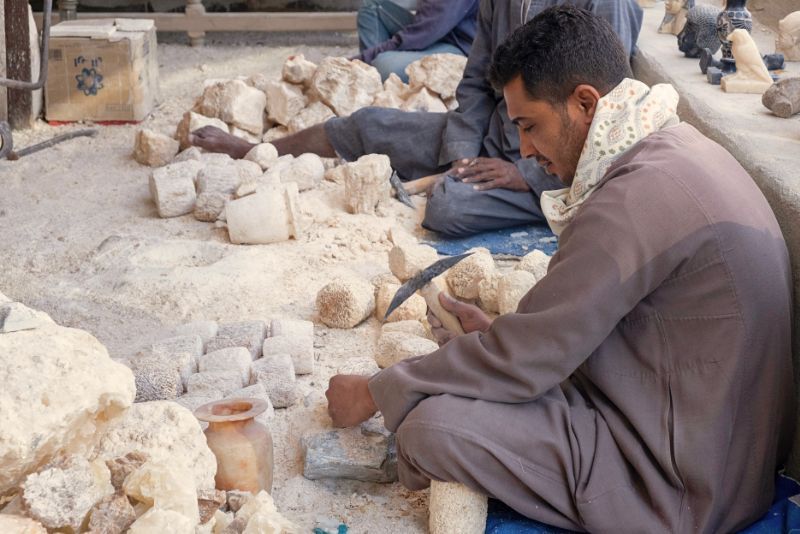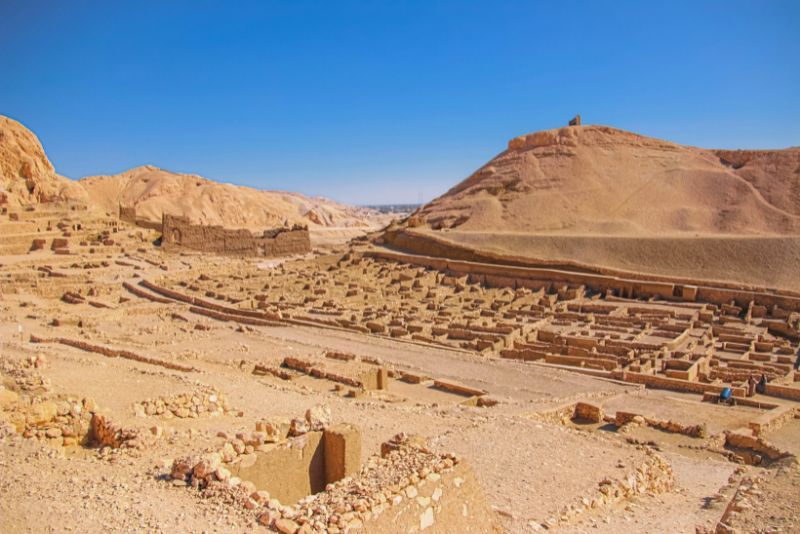Valley of the Artisans: Tickets and Tours
For Luxor visitors, the Valley of the Kings and the Valley of The Queens steal the spotlight. Venture off the beaten track and dig a little deeper into history, however, and you'll find another valley – that of the artisans – that, though not as royally glamorous, is equally fascinating without the busy tourist crowds.
The Valley of the Artisans, also known as Deir el-Medina, was used in Ancient Egypt as a royal workshop city where highly-skilled craftsmen (stone carvers, painters, sculptors, and builders) designed objects and royal tombs for the elite.
For Luxor visitors, the Valley of the Kings and the Valley of The Queens steal the spotlight. Venture off the beaten track and dig a little deeper into history, however, and you'll find another valley – that of the artisans – that, though not as royally glamorous, is equally fascinating without the busy tourist crowds.
The Valley of the Artisans, also known as Deir el-Medina, was used in Ancient Egypt as a royal workshop city where highly-skilled craftsmen (stone carvers, painters, sculptors, and builders) designed objects and royal tombs for the elite.

(0/24) checking Musement...
For Luxor visitors, the Valley of the Kings and the Valley of The Queens steal the spotlight. Venture off the beaten track and dig a little deeper into history, however, and you'll find another valley – that of the artisans – that, though not as royally glamorous, is equally fascinating without the busy tourist crowds.
The Valley of the Artisans, also known as Deir el-Medina, was used in Ancient Egypt as a royal workshop city where highly-skilled craftsmen (stone carvers, painters, sculptors, and builders) designed objects and royal tombs for the elite.
Today, it acts as a captivating archaeological site that offers a rare glimpse into the daily lives of these skilled laborers, their artistry, and the secrets they held. With tickets to the Valley of the Artisans in Luxor you will discover fascinating stories and be able to admire the rich history etched into the walls.

Here's all you need to know about visiting the Valley of the Artisans, one of the most exciting attractions in Luxor, tucked away in the shadows of the magnificent Valley of the Kings.
How much do Valley of the Artisans tickets cost?
Tickets to the Valley of the Artisans cost around US$5 (140 Egyptian pounds) for adults and $3 (70 Egyptian pounds) for kids. These tickets can be purchased from the main ticket office.
An extra ticket is needed to visit the tomb of Peshedu but prices can vary, so it's best to carry a little extra cash, just in case.
Who is eligible for discounts?
Students who carry valid ID cards, as well as military children, are usually eligible for discounted tickets to the Valley of the Artisans. To redeem a discount, just show your valid ID at the ticket office and you'll receive a lower price, usually 50% cheaper.
Should you book in advance?
If you plan on visiting the Valley of the Artisans on a guided tour, it's best to book your tickets in advance. This will ensure you can get the best prices and lock in your preferred dates.
If you plan on visiting independently, there is no need to book in advance. Just purchase your tickets when you arrive at the ticket office.
What are the best Valley of the Artisans tours?
If you want a more in-depth and educational experience, consider booking one of the many Valley of the Artisans tours. These usually include hotel pickup and drop-off as well as a guided walk through the site and visits to optional nearby attractions.
Valley of the Artisans tours are the perfect way to learn more about this fascinating area of Egypt's history. The most popular options are listed below.
Valley of the Artisans plus Valley of the Nobles and Medinet Habu Temple

Combining three of Luxor’s most captivating, yet underrated sites. This Valley of the Artisans tour is the perfect choice for those who want to explore more than just the mainstream attractions.
With its informative guide and comfortable transportation, you’ll get a comprehensive look into several of Egypt’s lesser-known ancient sites such as the Valley of the Nobles and the Medinet Habu Temple.
Valley of the Artisans plus Valley of the Queens and Medinet Habu Temple

This style of tour is ideal for those who want to explore a balance of popular sites and hidden gems. After being picked up from your hotel, you’ll venture to the lesser-known Valley of the Artisans, where you can discover tombs and temples.
Afterwards the tour will continue on to the infamous Valley of the Queens and the Medinet Habu Temple, home to the tomb of Ramesses III.
What will you see inside?
Once a thriving workers' site from the 18th to the 20th dynasty of ancient Egypt, the Valley of the Artisans now boasts fascinating archaeological remains that provide a glimpse into the age-old way of life.
When you visit, you’ll wander through the narrow streets, visit the workers' homes in the Residential Quarter (who created some of the tombs and relics for the nearby valleys of the kings and queens), admire wall paintings, and check out the archaeological excavations.

You'll also find a small temple dedicated to the Egyptian goddesses of love and truth, as well as three publicly open tombs: Inherka's tomb (No. 359), Sennedjem's tomb (No. 1) and Peshedu's tomb (No.3).
Papyrus documents and pottery fragments have also been found here, providing valuable insight into the daily lives of the villagers who lived here during Pharaonic times.
How to get there?
The Valley of the Artisans is located on the west bank of the Nile, near the Valley of the Kings. You can hire a taxi or drive the 35 minutes yourself, or take a boat across the river to cut your drive time in half.
Alternatively, if you are joining one of the Valley of the Artisans tours, transportation will be organized for you.
What are the opening times?
The site is open seven days a week, generally from 6 AM to 6 PM in the summertime and 6 AM to 5 PM in the winter. The last entry to the site is about one hour before closing time.
When is the best time to visit the Valley of the Artisans?

The best time to visit Deir Al-medina, whether independently or as part of a Valley of the Artisans tour, is in the morning from around 7 AM to 11 AM. This is usually when temperatures are cooler and crowds are smaller.
Which other attractions can be visited in Luxor?
Travel tips
- Students should apply for an International Student ID Card before leaving their home county, to access the 50% discount that can welcome discounts here and at other Luxor attractions.
- The entry fee includes admission to The Roman Temple, Tomb of Sennedjem and the Tomb of Inherkau, so make sure to visit them all while you're there.
- For the most in-depth experience, you should consider joining a guided tour with knowledgeable guides. The local experts provide extra insight into the area's history and significance.

